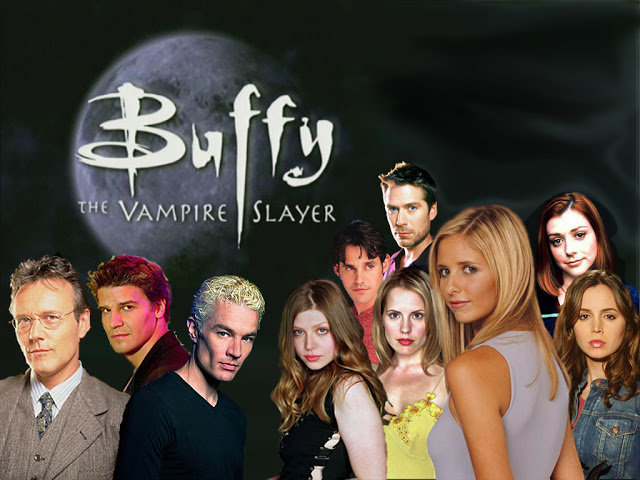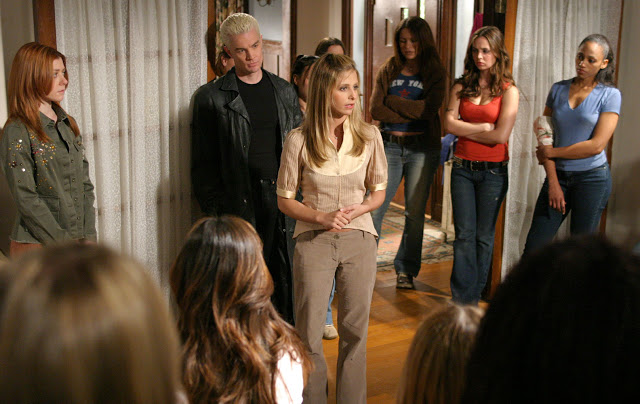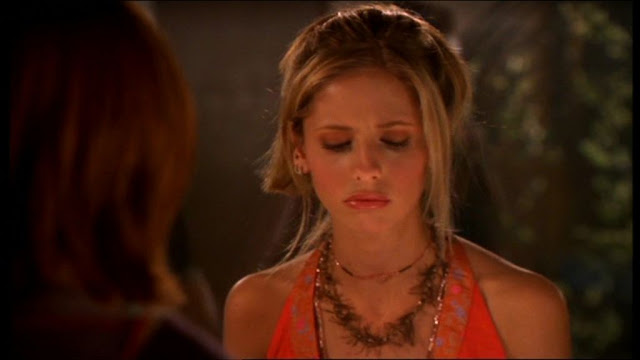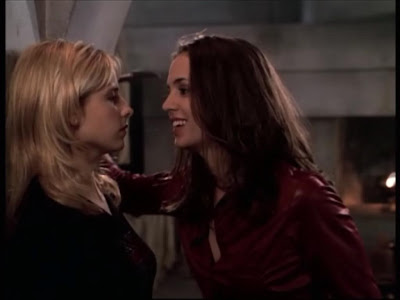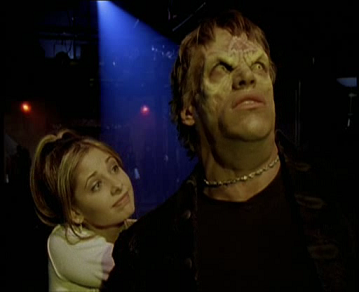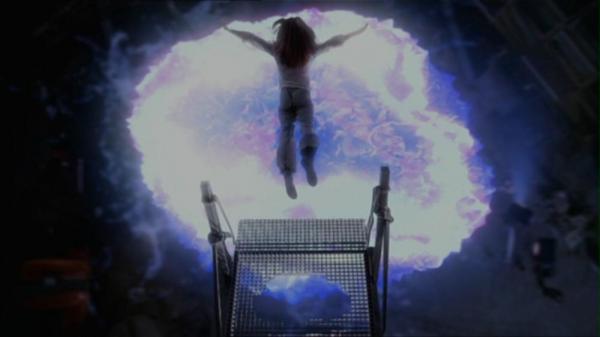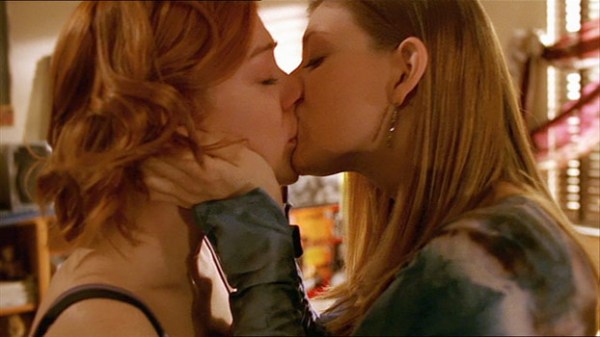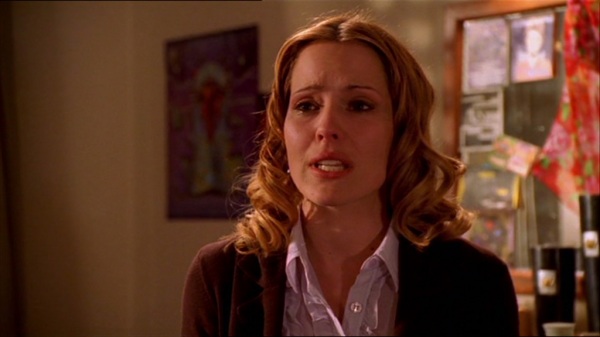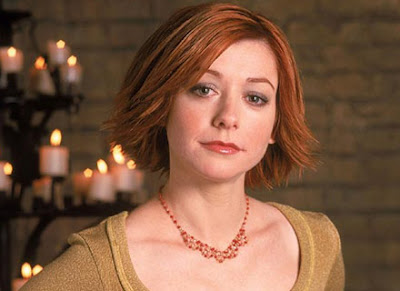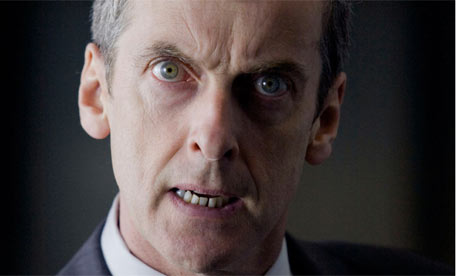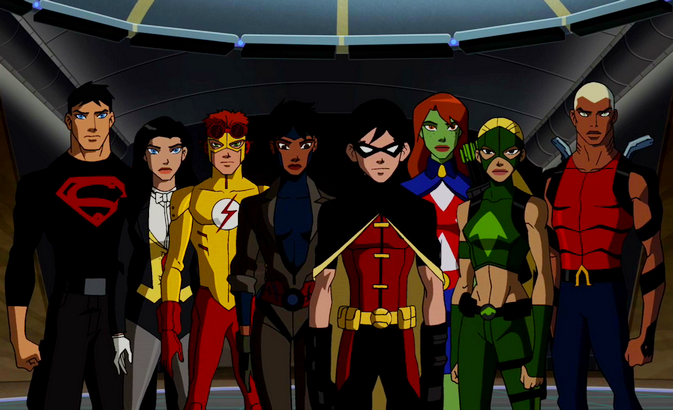 |
| The cast of Buffy the Vampire Slayer |
At the end of my first 45 minutes with Sunnydale’s finest, I remember feeling absolute delight. On the promise that they be returned in perfect condition, I borrowed one series after another of my friend’s treasured DVD boxsets, handed over with warnings and reverence, and received with the desperation of an addict. Needless to say I watched nothing but Buffy until reaching the final episode of Season 7 (it didn’t take long). I love this show. I believe it to be one of the most important television shows that has ever been conceived. Yes, there is the Riley blip, and Tara is no natural Scooby, despite her witchy credentials. But out of 144 episodes – that’s almost 7 days of watching Buffy continuously for 16 hours a day* (you’ve got to sleep right) – these niggles are small. It is a work of genius, and I will argue violently against any dissenters.
And yet … I am not particularly a fan of Buffy herself. I’m always on her side when she’s facing the bad guys, whether it’s The Master, Mayor Wilkins, Glory or the downright terrifying Caleb. But when it’s Willow, Faith or Anya that Buffy’s fighting, I can’t help feeling she sort of has it coming.
The entire show champions under-dogs: the nerdy, the quirky, and the excluded. People who aren’t classically beautiful; the unpopular ones that you’re embarrassed to hang out with; the screw-ups and lost souls. And with her perfect hair, kick-ass fighting skills, cool outfits, and dangerously sexy boyfriends, Buffy just doesn’t evoke the empathy of some of her fellow Scoobies. Sure, she has some romantic tangles along the way (excuse the enormous understatement), and definitely messes up occasionally: trying to kill her friends and sister; running away to leave Sunnydale to certain destruction; dying – all notable examples. But when it comes to saving the world, she delivers. She’s awesome at her job. And boy does she know it.
 |
| Faith, Buffy’s “rival” slayer |
So when Faith arrives and ends up rocking Buffy’s world, there’s a wonderful satisfaction in watching the pair battle it out. Unpredictable, sexy and wild, Faith personifies the dark side of Buffy: what she could have been if she wasn’t so annoyingly right all the time. But more than that, Faith’s psychological issues make her empathetic: her psychotic behaviour is not only understandable, but almost forgivable. From an unstable and implied abandoned background, Faith openly wishes for the wholesome simplicity Buffy’s life retains despite her Slayer responsibilities. She has a touchingly childlike desperation for the conventional stability that the Scoobies, Giles, Angel and Joyce provide for Buffy. The Mayor’s fatherly affection for Faith appears the only stable relationship she has ever come across, where she is treated like the innocent little girl she seems to have never been allowed to be. It is no wonder that she would do anything for him: wouldn’t most of us do anything for our family after all?
Faith is an emotional Slayer, and it is not a straightforward job for her – she is driven by instinct, pain and desperation, and pushes Buffy further than any of her other adversaries up until that point. When Buffy stabs her at the end of their final confrontation in Season 3, she commits the very action that she condemned Faith for. That Faith survives is the only thing which saves Buffy from a hypocrisy that will stalk her in further conflicts.
But when it comes to Buffy’s hypocrisy and double-standards, no situation makes them clearer than the moment she all too easily decides she has to kill Anya in Season 7’s “Selfless.” Being a bad-ass Vengeance Demon notorious across numerous hell dimensions, Anya is nowhere near as harmless as the bunnies she has an illogical phobia of. Her confrontation with Buffy is vicious, and bloody, and is without a doubt one fight we’re really not rooting for Buffy to win.
 |
| Vengeance Demon Anya |
Anya’s devastation after being jilted at the altar by Xander guts her emotionally. When she renews her status as a Vengeance Demon, it’s driven by desolation and grief. Like a lost soul she is doomed to meander through Sunnydale with no sense of purpose after her excruciating break-up with the love of her life, and finally resorts to her work as her only source of pride and fulfilment. The fact that that happens to include administering gory punishment to insensitive frat boys serves first to show the ravages her soul has endured – but subsequently her compassion when she bargains for them to be brought back to life.
Similarly Xander is all too aware of how painful the repercussions of his commitment-phobia are, and pleads with Buffy not to kill his one true love. When Buffy tells him she faced this problem when she stabbed Angel way back in Season 2, I can’t be the only one that felt she had milked that drama one time too many! And here’s why … To compare that relationship with Xander and Anya’s is immature at best, and delusional at worst. Xander and Anya move in together. They get engaged. They profess their love for one another openly. They plan to have children. They can spend whole days together without apocalypse as an excuse. And most importantly of all, they have lots and lots of sex.
Their physical connection, their delight in carnal intimacy, their inappropriate lustful outbursts are demonstrations that Anya and Xander are a grown-up couple. To compare the adult subtleties of the way they relate to one another with the doomed fairytale of Buffy’s teenage love affair shows a complete lack of empathy and understanding on Buffy’s part. She has no idea what it is like to experience love of the kind Anya and Xander share: where it isn’t “end-of-the-world” urgency all the time! Her response to Xander’s pleas with, “I am the law,” before leaving to kill fellow Scooby, Anya, out of some presumed sense of morality simply reeks of arrogance. 
Thankfully, Anya survives Buffy’s assault, and in doing so she gives her a glimmer of insight into the lengths love, and not responsibility, will drive a person to. Amazing that after the show’s most exhilarating confrontation of all, she’d need a reminder of that, but it’s a lesson Buffy clearly doesn’t learn easily.
Buffy vs Willow: replacing “and” with “vs” surely never had a more devastatingly exciting depiction onscreen!
As one of the most popular characters, and with an incredibly complex character arc, Willow is arguably the reason why I love this show so much! Endlessly patient and studious throughout Seasons 1 and 2, over time Willow transforms into the embodiment of the “Woman Scorned” becoming a murderous and merciless master of dark magic in Season 6. In this gothic incarnation of unrestrained power Willow expresses all the suppressed frustrations she’s endured as Buffy’s “sideman.” She flaunts her strength, exhibits her magical prowess and becomes the personification of her enraged emotions. There’s a cathartic thrill at seeing someone previously so meek rebel. Countless times over numerous episodes we watch Willow put her own dramas to one side to prioritise Buffy’s needs, but with the death of Willow’s soul-mate she finally lets her instincts take over. Right or wrong lose significance and at last, Willow’s emotional needs are given priority – that she almost destroys the world in the process doesn’t say much for Buffy’s ability to empathise with her dearest friends!
 |
| Dark Willow |
So whilst Buffy can defeat demons and save the world over and over, her emotional detachment and self-righteous sense of martyrdom (have some humility woman!) make these fights she doesn’t actually win, absolutely crucial to the Series’ greatness. Ultimately that’s why I find it hard not to let out a little yelp of glee when Dark Willow declares, “You really need to have every square inch of your ass kicked.” Faith, Willow and Anya teach Buffy to lose the ego and remember what she’s really fighting for, and that’s feminism in action right there.
*I am no mathematician, and it is testament to my love for Buffy that I actually worked this out.
———-
